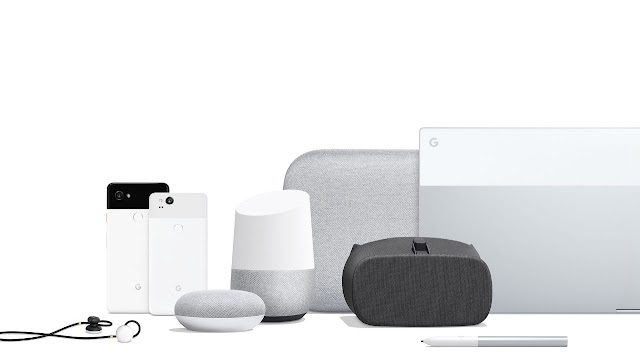Today, we
introduced our second generation family of consumer hardware products that are coming to Canada, all made by Google: new Pixel phones, Google Home Mini and Max, an all new Pixelbook, Google Pixel Buds, and an updated Daydream View headset. We see tremendous potential for devices to be helpful, make your life easier, and even get better over time when they’re created at the intersection of hardware, software and advanced artificial intelligence (AI).
 Why Google?
Why Google? These days many devices—especially smartphones—look and act the same. That means in order to create a meaningful experience for users, we need a different approach. A year ago, Sundar
outlined his vision of how AI would change how people would use computers. And in fact, AI is already transforming what Google’s products can do in the real world. For example, swipe typing has been around for a while, but AI lets people use
Gboard to swipe-type in two languages at once. Google Maps uses AI to figure out what the parking is like at your destination and suggest alternative spots before you’ve even put your foot on the gas. But, for this wave of computing to reach new breakthroughs, we have to build software
and hardware that can bring more of the potential of AI into reality—which is what we’ve set out to do with this year’s new family of products.
Hardware, built from the inside out We’ve designed and built our latest hardware products around a few core tenets. First and foremost, we want them to be radically helpful. They’re fast, they’re there when you need them, and they’re simple to use. Second, everything is designed for you, so that the technology doesn’t get in the way and instead blends into your lifestyle. Lastly, by creating hardware with AI at the core, our products can improve over time. They’re constantly getting better and faster through automatic software updates. And they’re designed to learn from you, so you’ll notice features—like the Google Assistant—get smarter and more assistive the more you interact with them.
You’ll see this reflected in our 2017 lineup of new Made by Google products:
- The Pixel 2 has the best camera of any smartphone, again, along with a gorgeous display and augmented reality capabilities. Pixel owners get unlimited storage for their photos and videos, and an exclusive preview of Google Lens, which uses AI to give you helpful information about the things around you.
- Google Home Mini brings the Assistant to more places throughout your home, with a beautiful design that fits anywhere. And Max, which is coming later to Canada, is our biggest and best-sounding Google Home device, powered by the Assistant. And with AI-based Smart Sound, Max has the ability to adapt your audio experience to you—your environment, context, and preferences.
- With Pixelbook, we’ve reimagined the laptop as a high-performance Chromebook, with a versatile form factor that works the way you do. It’s the first laptop with the Assistant built in, and the Pixelbook Pen makes the whole experience even smarter.
- Our new Pixel Buds combine Google smarts and the best digital sound. You’ll get elegant touch controls that put the Assistant just a tap away, and they’ll even help you communicate in a different language.
- The updated Daydream View is the best mobile virtual reality (VR) headset on the market, and the simplest, most comfortable VR experience.
Assistant, everywhere Across all these devices, you can interact with
the Google Assistant any way you want—talk to it with your Google Home or your Pixel Buds, squeeze your Pixel 2, or use your Pixelbook’s Assistant key or circle things on your screen with the Pixelbook Pen. Wherever you are, and on any device with the Assistant, you can connect to the information you need and get help with the tasks to get you through your day. No other assistive technology comes close, and it continues to get better every day.
Google’s hardware business is just getting started, and we’re committed to building and investing for the long run. We couldn’t be more excited to introduce you to our second-generation family of products that truly brings together the best of Google software, thoughtfully designed hardware with cutting-edge AI. We hope you enjoy using them as much as we do.
AvailabilityHere’s some more info on where and when you can get our new hardware in Canada. Visit
The Google Store for more info.
- Pixel 2 and Pixel 2 XL are available for pre-order today, starting at $899, on The Google Store, Bell, Best Buy Canada, Fido, Freedom Mobile, Koodo, Rogers, The Source, TELUS, Tbooth wireless, Walmart, WIRELESSWAVE, Videotron, and Virgin.
- Pixel Buds will be available later this year for $219 on The Google Store and Best Buy Canada.
- Pixelbook is available in three configurations starting at $1299, so you can choose the processing power, memory and storage you want. The Pixelbook Pen is $129. Both will be available for pre-order today in Canada, with the exception of Quebec, and on sale at The Google Store and select retailers, including Best Buy Canada. We’re working to bring Pixelbook to Quebec in the future.
- Google Home Mini is available for pre-order today for $79 on The Google Store, Best Buy Canada and select retailers.
- The new Google Daydream View is available for pre-order today for $139 on The Google Store and select retailers.
Posted by Rick Osterloh, SVP, Hardware


